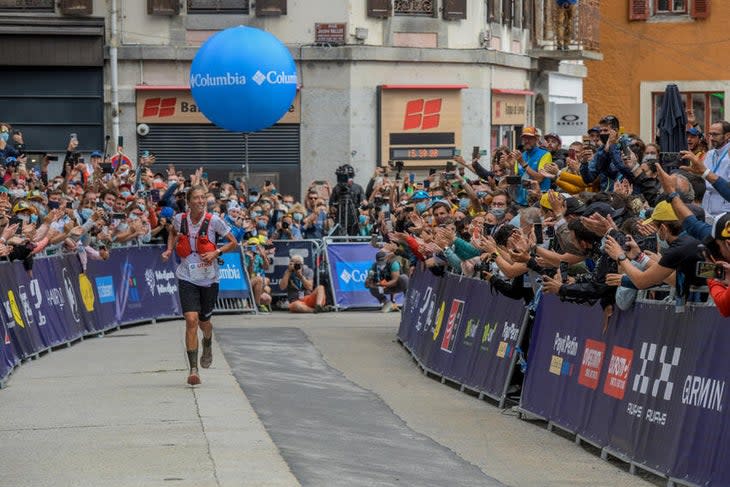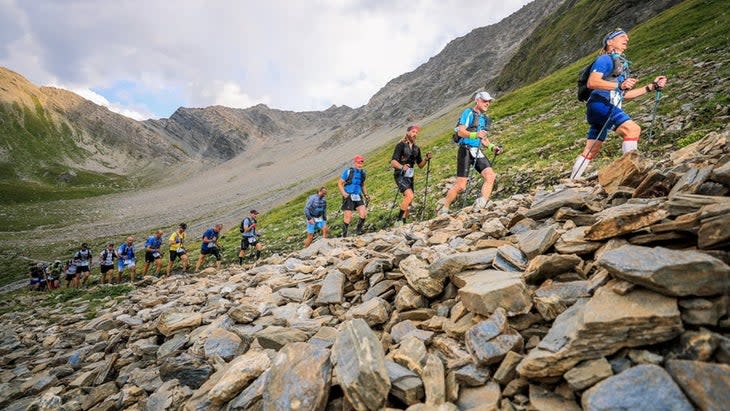Will 2022 Be The Last Big UTMB?
This article originally appeared on Trail Runner
With big changes on the horizon for the Ultra-Trail du Mont Blanc (UTMB) races, this year's events might be some of the most competitive ever. What does it mean for the future of the Chamonix-based event, and for the future of the sport of trail running?
Is this The Most Competitive UTMB Ever?
The UTMB start list is a who's who of trail running. There are 172 men with ITRA scores over 800, which is considered elite (International Trail Running Association's ranking system, used more widely in Europe than the U.S., where points are awarded for competing at races that pay to be a part of the system). It's the biggest assemblage of elite runners in the world by a long shot, far ahead of contenders like the Western States Endurance Run (while competitive, only a few hundred racers, compared to several thousand). Eight of the world's top male runners (with the exception of Francois D'Haene and Adam Peterman) are competing.
For the women's field, there are 35 entrants ranked over 670 in the ITRA index, which is considered elite. Even with two-time champion Courtney Dauwalter absent, the women's field will be packed at the top. Statistically speaking (according to ITRA scores of registered participants), the 100K CCC is just as - if not more - competitive than its 106-mile counterpart, the flagship UTMB.
Across the full UTMB series (including all World Series events), there's room for about 80,000 runners to participate (according to UTMB, they're at about 75% capacity), and about 10,000 will toe the line in Chamonix. This year, the lottery for CCC was even more competitive than for the 106-mile run around Mont Blanc.
RELATED: Trail Runner's Guide To UTMB 2022
"The 2022 UTMB is definitely one of the most competitive 100-mile fields ever assembled. The men’s race is highlighted by three past champions who are responsible for seven of the last thirteen victories. Meanwhile, there are zero past champions in the women’s race, leaving the field crazy competitive though without a clear group of favorites," says Freetrail's Dylan Bowman, a former UTMB competitor and current announcer for the event. Bowman notes that former champions D'Haene and Dauwalter are not toeing the line this year. "But realistically, I think only 2017’s field can rival 2022." (2017's men’s field included D'Haene, Kilian Jornet, Xavier Thevenard, Pau Capell, Dylan Bowman, Tim Tollefson, and Jim Walmsley. The women’s field included Nuria Picas, Andrea Huser, Christelle Bard, Alissa St Laurent – and included a simultaneous finish from Kaci Lickteig, Amanda Basham, and Maga Boulet.)

Corrinne Malcolm, who's running the 145K (90-mile) TDS on August 23 and who is in charge of the English language coverage for this year's event series, says context is important when looking at how competitive the field is for this year's race.
"I think it’s really easy to look at the start list for any major race year after year and say 'this is the most competitive ever,' and while to a degree the sport as a whole is definitely getting more competitive and the fields are getting deeper, I think broadly we are looking at similar competitive levels from the past five years for most races – including UTMB," says Malcolm. "While UTMB is definitely a strong field, and there will be a sharp end in both the men’s and women’s races, I think the most impressive growth has actually been in CCC and OCC over the last few years – those races have leveled up. How many men went under the old OCC [course record] last year? This year’s women’s CCC field is a dream! The other major question I have right now is, while the fields look deep as is, how many of those individuals are not making it to the start line due to injury, illness, or other responsibilities? And how many of them cooked themselves in earlier season races and are tacking on a UTMB race as the “end of the season”? This historically does not work well for people."
Changing Rules and the Future of UTMB
Starting in 2023, runners who want to compete in the Chamonix UTMB races (OCC, CCC, TDS and UTMB) need to have acquired at least one Running Stone in the last two years and have a registered UTMB Index (previously ITRA score) to compete. Whereas elite athletes used to be able to skip the lottery with a high enough ITRA score, elites will now have to compete in at least one of twenty-three UTMB World Series events to have a shot at running in Chamonix. A Running Stone is essentially a lottery ticket to compete in the UTMB World Series Finals (the races in Chamonix: OCC, CCC, TDS, UTMB, etc), and each Stone athletes earn gives them an additional chance to get in via the lottery.
This new system mandates participation in "by UTMB" events around the world. In the U.S., runners need to compete in the Western States Endurance Run (already a prominent lottery event) the Canyons Endurance Runs, or Speedgoat Mountain races. There are also UTMB World Series events in Mexico, Thailand, Hong Kong, and China.
Whereas elite athletes used to be able to skip the lottery with a high enough ITRA score, elites will now have to compete in at least one of twenty-three UTMB World Series events to have a shot at running in Chamonix.
"This will be very interesting to observe in the coming years," says Bowman. "While the changes might level the playing field and likely improve fairness between pro and amateur athletes, I suspect it might reduce competitive density in the future, simply because it adds friction to the elite registration process."
Top athletes like Dauwalter and D'Haene haven't yet raced in a UTMB World Series event, and according to the race series, UTMB will save some "wild card" entries for top-level elites. The top three runners in a World Series event get automatic entry to the Chamonix races, though the exact qualifying races may change year to year. For UTMB Major Races, the top ten athletes at the 50K, 100K and 100M distance earn a spot at UTMB. While there isn't yet a major in the U.S (Canyons, Western States, and Speedgoat are World Series races, not UTMB Major events), a source at the race organization says that they hope to get one in the works soon.
Malcolm agrees that the changes will likely affect how competitive UTMB championship events are.
"The change in rules actually makes me really concerned for the depth of the elite field," Malcolm says. "I honestly think it has a possibility of shrinking the fields for next year. The pressure for the pro fields to make it to a UTMB series race is a complication – particularly if you race at the longer distances and are trying to get a qualifier in June for example (when there are so many). Is that the perfect prep race if you may have to go to the well to secure a top three there only to show up in Chamonix six weeks later?”

And it's not just the logistics. Money is a serious question for athletes considering qualifying for UTMB.
"From a socioeconomic standpoint, the new stones system has made it even harder for middle class runners to have the opportunity to run UTMB," says Finn Melanson, host of the Singletrack podcast. Now, in addition to funding a trip to Chamonix for the championship races, runners also have to pony up for another UTMB race. Previously, runners could get points toward UTMB at local events. Now, they'll have to travel to one of just a few qualifying events around the globe. "That said, this is great news for local and independent races, if more runners voluntarily or involuntarily opt out of pursuing UTMB because of the changes."
What Does it Mean for the Future of Trail Running?
So, how will these consolidations affect most of us trail runners? Melanson thinks that it's not all bad news when it comes to growing the sport.
"There isn’t a single case study (that I’m aware of) indicating that a sport has significantly grown their fan base by focusing on the grassroots (increasing participation at younger ages and/or community levels). It all happens by improving the product and associated media coverage at the very top end of the sport," says Melanson. "Time and time again (ex: NFL, NBA, MLB) the successful playbook has been to invest around the professionals in the sport.."
The UTMB Live platform will provide coverage for seven of the series' events, so fans can livestream races in Nice, France; Thailand; Val d'Aran, Spain; and Verbier, Switzerland, among others. Viewers will be able to track amateurs and elites alike with a new, in-depth platform.
Melanson thinks consolidation of UTMB events could be a positive step for trail running because it concentrates more talent on fewer start lines – making a few choice races more competitive. He does, however, wish that UTMB's version of a "golden ticket series" was getting more attention. Twenty-five races around the world will grant female and male podium finishers (not to mention the top ten finishers of all the Major races) automatic entry to UTMB, making those smaller races more exciting to watch for fans of the sport of ultrarunning.
"My hope is that this gives younger athletes the incentive to take a gradual approach to the sport, developing over longer time horizons, and hopefully enhancing career longevity for the best athletes," says Bowman.
Time will tell how the new strategy plays out, but it's clear that there are pro's and cons to the coalescence of power and attention in the sport. All eyes will be on Chamonix next week at one of our sport's most competitive races ever, and one thing is for sure: it will be a history-making race.
For exclusive access to all of our fitness, gear, adventure, and travel stories, plus discounts on trips, events, and gear, sign up for Outside+ today.